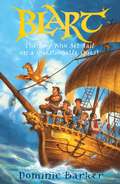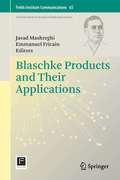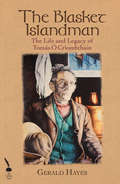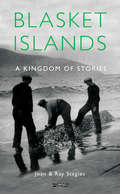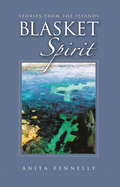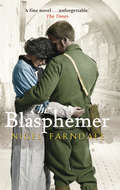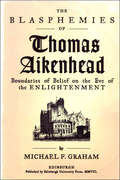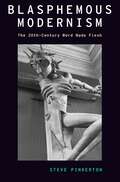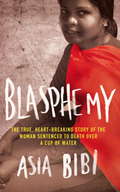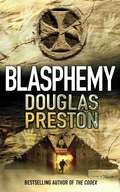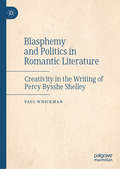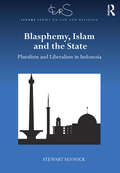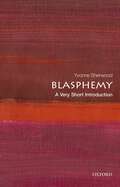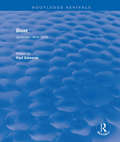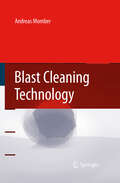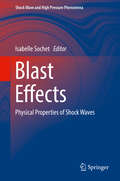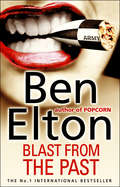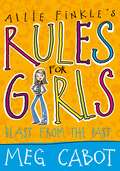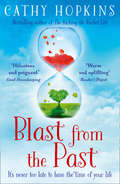- Table View
- List View
Blart 3: The boy who set sail on a questionable quest
by Dominic BarkerPrincess Lois has been kidnapped by Anatoly the Handsome, who wants to marry her. Cue 'damsel in distress' to be rescued by none other than our own heroic Blart. He sets out on the good ship The Golden Pig with Olaf the innocent - who believes what everyone says all the time - and Kupverstich the Strange - an explorer-come-scientist whose ingenious explanations for the natural world have one thing in common: they're all wrong. They must battle cut-throat pirates, a sixteen-tentacled octopus, escape the suffocating bureaucracy of Triplicat, where they are briefly marooned, not to mention evade the Guild of Assassins, who have a contract to kill Blart, in their selfless (well, almost) bid to rescue poor Lois. But will they make it in time?
Blaschke Products and Their Applications (Fields Institute Communications #65)
by Javad Mashreghi Emmanuel FricainBlaschke Products and Their Applications presents a collection of survey articles that examine Blaschke products and several of its applications to fields such as approximation theory, differential equations, dynamical systems, harmonic analysis, to name a few. Additionally, this volume illustrates the historical roots of Blaschke products and highlights key research on this topic. For nearly a century, Blaschke products have been researched. Their boundary behaviour, the asymptomatic growth of various integral means and their derivatives, their applications within several branches of mathematics, and their membership in different function spaces and their dynamics, are a few examples of where Blaschke products have shown to be important. The contributions written by experts from various fields of mathematical research will engage graduate students and researches alike, bringing the reader to the forefront of research in the topic. The readers will also discover the various open problems, enabling them to better pursue their own research.
The Blasket Islandman: The Life and Legacy of Tomás Ó Criomhthain
by Gerald HayesTomás Ó Criomhthain (1856–1937) is one of the giants of Irish-language literature. His best-known books, Allagar na hInise and An tOileánach, are acknowledged classics. But he was a highly unlikely author. He lived his entire life on the isolated and now-abandoned Great Blasket, in a house he built with his own hands using stones he found on the island. Likewise, he crafted a valuable literary heritage out of island life. With indefatigable persistence, he steadily built on his modest formal education, learning to read and write in Irish during middle age while simultaneously expanding his knowledge of literature and history. Scholarly visitors were impressed with Tomás’s observations of his tiny community. They encouraged him to commit his stories and memories to paper. He wrote three first-person accounts of his experiences, bequeathing to us a captivating saga of a folk culture doomed by difficult circumstances. His works are among the first examples of Ireland’s transition from oral to written folk storytelling. The Blasket Islandman tells, for the first time, the full story of Tomás’s life, with its many triumphs and travails. This absorbing account also describes the forces that influenced his work and details his impressive legacy. Tomás was determined that his community be remembered. In the process, he achieved a level of immortality for himself. More than eighty years after his passing, he remains the famed ‘Blasket Islandman’ and, to paraphrase the man himself, the like of him will never be again.
Blasket Islands: A Kingdom of Stories
by Joan Stagles Ray StaglesThe Blasket Islands are famous for their writers, lore and unique location off the south-west tip of Ireland. This book is perfect for anyone who wants to explore the Great Blasket Island, learn its history and discover what has captivated visitors and residents in this special place. A beautifully illustrated and compelling history of the life, traditions and customs of an isolated community that has now disappeared. The book traces the fate of the Blasket people and the slow erosion of their culture to that sad day in 1952 when the families were evacuated from the Great Blasket Island.
Blasket Spirit: Stories from the Islands
by Anita FennellySeeking solitude after personal crisis, Anita Fennelly spent a summer alone on the Great Blasket Island. This is her story, written by candelight, of personal healing and recovery interwoven with the island stories, its people, places and wildlife. Anita weaves a tapestry of tales: ghost stories told by the fireside, stories of love and betrayal, stories celebrating womanhood. Ultimately, Anita's own story is one of survival and hope. Blasket Spirit reveals a timeless place where the souls of the past and present are inextricably linked with the emotional and physical struggles of island life.
The Blasphemer: A Novel
by Nigel FarndaleHe had always been scared of flying. Now, the fear is real. A plane crash. The water is rising over his mouth. In his nostrils. Lungs. As Daniel gasps, he swallows; and punches at his seat-belt. Nancy, the woman he loves, is trapped in her seat. He clambers over her, pushing her face into the headrest.It is a reflex, visceral action made without rational thought...But Daniel Kennedy did it. And already we have judged him from the comfort of our own lives.Almost a hundred years earlier, Daniel's great-grandfather goes over the top at Passchendaele.A shell explodes, and he wakes up alone and lost in the hell of no-man's-land. Where are the others? Has he been left behind? And if he doesn't find his unit, is he a deserter?Love; cowardice; trust; forgiveness.How will any of us behave when we are pushed to extremes?
The Blasphemies of Thomas Aikenhead: Boundaries of Belief on the Eve of the Enlightenment
by Michael F. GrahamThis is the first modern book-length study of the case of Thomas Aikenhead, the sometime University of Edinburgh student who in 1697 earned the unfortunate distinction of being the last person executed for blasphemy in Britain.
Blasphemous Modernism: The 20th-Century Word Made Flesh (Modernist Literature and Culture)
by Steve PinkertonScholars have long described modernism as "heretical" or "iconoclastic" in its assaults on secular traditions of form, genre, and decorum. Yet critics have paid surprisingly little attention to the related category of blasphemy--the rhetoric of religious offense--and to the specific ways this rhetoric operates in, and as, literary modernism. United by a shared commitment to "the word made flesh," writers such as James Joyce, Mina Loy, Richard Bruce Nugent, and Djuna Barnes made blasphemy a key component of their modernist practice, profaning the very scriptures and sacraments that fueled their art. In doing so they belied T. S. Eliot's verdict that the forces of secularization had rendered blasphemy obsolete in an increasingly godless century ("a world in which blasphemy is impossible"); their poems and fictions reveal how forcefully religion endured as a cultural force after the Death of God. More, their transgressions spotlight a politics of religion that has seldom engaged the attention of modernist studies. Blasphemy respects no division of church and state, and neither do the writers who wield it to profane all manner of coercive dogmas--including ecclesiastical as well as more worldly ideologies of race, class, nation, empire, gender, and sexuality. The late-century example of Salman Rushdie's The Satanic Verses affords, finally, a demonstration of how modernism persists in postwar anglophone literature and of the critical role blasphemy plays in that persistence. Blasphemous Modernism thus resonates with the broader cultural and ideological concerns that in recent years have enriched the scope of modernist scholarship.
Blasphemous Modernism: The 20th-Century Word Made Flesh (Modernist Literature and Culture)
by Steve PinkertonScholars have long described modernism as "heretical" or "iconoclastic" in its assaults on secular traditions of form, genre, and decorum. Yet critics have paid surprisingly little attention to the related category of blasphemy--the rhetoric of religious offense--and to the specific ways this rhetoric operates in, and as, literary modernism. United by a shared commitment to "the word made flesh," writers such as James Joyce, Mina Loy, Richard Bruce Nugent, and Djuna Barnes made blasphemy a key component of their modernist practice, profaning the very scriptures and sacraments that fueled their art. In doing so they belied T. S. Eliot's verdict that the forces of secularization had rendered blasphemy obsolete in an increasingly godless century ("a world in which blasphemy is impossible"); their poems and fictions reveal how forcefully religion endured as a cultural force after the Death of God. More, their transgressions spotlight a politics of religion that has seldom engaged the attention of modernist studies. Blasphemy respects no division of church and state, and neither do the writers who wield it to profane all manner of coercive dogmas--including ecclesiastical as well as more worldly ideologies of race, class, nation, empire, gender, and sexuality. The late-century example of Salman Rushdie's The Satanic Verses affords, finally, a demonstration of how modernism persists in postwar anglophone literature and of the critical role blasphemy plays in that persistence. Blasphemous Modernism thus resonates with the broader cultural and ideological concerns that in recent years have enriched the scope of modernist scholarship.
Blasphemy: The true, heartbreaking story of the woman sentenced to death over a cup of water
by Asia BibiPunjab, Pakistan, June 2009. The temperature is 45° and Asia has been out picking fruit for several hours. It's exhausting, sweaty work, but Asia and her husband have five children to feed. At midday she goes to the nearest well, picks up a cup and takes a long drink of cool water. She refills the cup, drinks some more and then offers it to another woman.Suddenly one of her fellow workers cries out that the water belongs to the Muslim women and that with her actions, Asia - who is Christian - has contaminated it. An argument ignites and in an instant, with one word, Asia's fate is sealed. 'Blasphemy!' someone shouts. In Pakistan this is a charge punishable by death.First attacked by a mob, Asia was soon after thrown into prison and then sentenced to be hanged. Since then she has been kept in a windowless cell. Her family have had to flee their village, under threat from vengeful extremists. In the wave of accusation that followed, only two public figures came to Asia's defence: the Muslim governor of the Punjab and Pakistan's Christian Minister for Minorities. Both have since been brutally murdered. Here, in equal measures shocking and inspiring, Asia Bibi, who has become a symbol for everyone concerned with ending the violence committed in the name of religion, bravely speaks to us from her prison cell.
Blasphemy: (tyrannosaur Canyon, Blasphemy, Impact, The Kraken Project) (Wyman Ford #2)
by Douglas PrestonDeep in an Arizona mountain, the world’s largest supercollider will probe what happened at the very moment of creation: the Big Bang itself. The brainchild of Nobel laureate Gregory North Hazelius, the supercollider, given the name Isabella, is the most expensive machine ever built. Some people think it may unlock the mysteries of the universe. Some think it will create a mini black hole that will suck in the earth. Powerful televangelist Don T. Spates thunders that Isabella is a satanic attempt to disprove Genesis and challenge God Almighty on the very throne of heaven. He’ll do anything to stop Isabella from reaching its goal. When Hazelius and his team of twelve scientists start up Isabella, they make an extraordinary discovery – one that must be hidden from the world at all costs. Wyman Ford, ex-monk and CIA operative, is hired by the US government to wrest from the team their dark secret. A secret that will either destroy the world . . . or save it. ‘This baby roars . . . the pages simply fly’ Publishers Weekly ‘A superb read! A page-turning thriller about science and religion in which good and evil collide at the speed of light. You’ll be up all night with this book’ Jeffrey Deaver
Blasphemy and Politics in Romantic Literature: Creativity in the Writing of Percy Bysshe Shelley
by Paul WhickmanThis book argues for the importance of blasphemy in shaping the literature and readership of Percy Bysshe Shelley and of the Romantic period more broadly. Not only are perceptions of blasphemy taken to be inextricable from politics, this book also argues for blasphemous ‘irreverence’ as both inspiring and necessitating new poetic creativity. The book reveals the intersection of blasphemy, censorship and literary property throughout the ‘Long Eighteenth Century’, attesting to the effect of this connection on Shelley’s poetry more specifically. Paul Whickman notes how Shelley’s perceived blasphemy determined the nature and readership of his published works through censorship and literary piracy. Simultaneously, Whickman crucially shows that aesthetics, content and the printed form of the physical text are interconnected and that Shelley’s political and philosophical views manifest themselves in his writing both formally and thematically.
Blasphemy, Islam and the State: Pluralism and Liberalism in Indonesia (ICLARS Series on Law and Religion)
by Stewart FenwickThis book draws on the work of Rawls to explore the interaction between faith, law and the right to religious freedom in post-Soeharto Indonesia, the world’s largest democracy after India and the United States. It argues that enforcement of Islamic principles by the state is inconsistent with religious diversity and the country’s liberal constitution. The book thus contributes to understanding the role of religion in the development of democracy in the world’s largest Muslim nation. A key objective is to test the argument that Rawls’ thinking about public reason cannot apply to the case of Indonesia, and Muslim states more broadly. The book therefore contributes to emerging scholarship that considers Rawls in a Muslim context. In addition to examining public reason in detail and considering critiques of the concept, the work highlights the fact that the theory was created to deal with value pluralism and is therefore relevant in any religious setting, including an Islamic one. In doing so, it emphasises that Islam is multifaceted and demonstrates the difficulties, and negative consequences, of integrating faith and law in a liberal state.
Blasphemy, Islam and the State: Pluralism and Liberalism in Indonesia (ICLARS Series on Law and Religion)
by Stewart FenwickThis book draws on the work of Rawls to explore the interaction between faith, law and the right to religious freedom in post-Soeharto Indonesia, the world’s largest democracy after India and the United States. It argues that enforcement of Islamic principles by the state is inconsistent with religious diversity and the country’s liberal constitution. The book thus contributes to understanding the role of religion in the development of democracy in the world’s largest Muslim nation. A key objective is to test the argument that Rawls’ thinking about public reason cannot apply to the case of Indonesia, and Muslim states more broadly. The book therefore contributes to emerging scholarship that considers Rawls in a Muslim context. In addition to examining public reason in detail and considering critiques of the concept, the work highlights the fact that the theory was created to deal with value pluralism and is therefore relevant in any religious setting, including an Islamic one. In doing so, it emphasises that Islam is multifaceted and demonstrates the difficulties, and negative consequences, of integrating faith and law in a liberal state.
Blasphemy: A Very Short Introduction (Very Short Introductions)
by Yvonne SherwoodIn a world where not everyone believes in God, 'blasphemy' is surely a concept that has passed its use-by-date. And yet blasphemy (like God and religion) seems to be on the rise. In this Very Short Introduction Yvonne Sherwood asks why this should be the case, looking at factors such as the increased visibility of religious and racial minorities, new media, and engines of surveillance (which are far more omniscient than the old gods could ever be), and the legacies of colonial blasphemy laws. Throughout, Sherwood uncovers new histories, from the story of accidentally blasphemous cartoons, to the close associations between blasphemy, sex, and birth control. She also argues that blasphemy itself involves an inherent contradiction in imagining the divine as an entity that must be revered above all, yet also a being that could possibly be hurt by anything that happens in the merely human sphere. Unpicking some of the most famous cases of blasphemy, Sherwood also looks at obscure instances, asking why some 'blasphemies' have become infamous, while others have disappeared. Very Short Introductions: Brilliant, Sharp, Inspiring ABOUT THE SERIES: The Very Short Introductions series from Oxford University Press contains hundreds of titles in almost every subject area. These pocket-sized books are the perfect way to get ahead in a new subject quickly. Our expert authors combine facts, analysis, perspective, new ideas, and enthusiasm to make interesting and challenging topics highly readable.
Blasphemy: A Very Short Introduction (Very Short Introductions)
by Yvonne SherwoodIn a world where not everyone believes in God, 'blasphemy' is surely a concept that has passed its use-by-date. And yet blasphemy (like God and religion) seems to be on the rise. In this Very Short Introduction Yvonne Sherwood asks why this should be the case, looking at factors such as the increased visibility of religious and racial minorities, new media, and engines of surveillance (which are far more omniscient than the old gods could ever be), and the legacies of colonial blasphemy laws. Throughout, Sherwood uncovers new histories, from the story of accidentally blasphemous cartoons, to the close associations between blasphemy, sex, and birth control. She also argues that blasphemy itself involves an inherent contradiction in imagining the divine as an entity that must be revered above all, yet also a being that could possibly be hurt by anything that happens in the merely human sphere. Unpicking some of the most famous cases of blasphemy, Sherwood also looks at obscure instances, asking why some 'blasphemies' have become infamous, while others have disappeared. Very Short Introductions: Brilliant, Sharp, Inspiring ABOUT THE SERIES: The Very Short Introductions series from Oxford University Press contains hundreds of titles in almost every subject area. These pocket-sized books are the perfect way to get ahead in a new subject quickly. Our expert authors combine facts, analysis, perspective, new ideas, and enthusiasm to make interesting and challenging topics highly readable.
Blast: Vorticism, 1914-1918 (Routledge Revivals)
by Paul EdwardsThis title was first published in 2000. Founded in 1914 by Wyndham Lewis and christened by Ezra Pound, the Vorticism movement was a sustained act of aggression against the moribund Victorianism seen as stifling to artistic energies. Inspired by the example of F.T.Marinetti and the Futurists, the Vorticists were nevertheless harshly critical of the Futurists' naive enthusiasm for modernity. They created their own style of geometric abstraction to celebrate the new consciousness of humanity in a mechanized urban environment. But their splintered and discordant style also measured the cost of the psychic disruption that modernity caused. This illustrated guide to the movement covers topics including sculpture, painting, literary Vorticism, women in Vorticism and Vorticist aesthetics.
Blast: Vorticism, 1914-1918 (Routledge Revivals)
by Paul Edwards Jane Beckett Deborah Cherry Richard Cork Karin Orchard Andrew WilsonThis title was first published in 2000. Founded in 1914 by Wyndham Lewis and christened by Ezra Pound, the Vorticism movement was a sustained act of aggression against the moribund Victorianism seen as stifling to artistic energies. Inspired by the example of F.T.Marinetti and the Futurists, the Vorticists were nevertheless harshly critical of the Futurists' naive enthusiasm for modernity. They created their own style of geometric abstraction to celebrate the new consciousness of humanity in a mechanized urban environment. But their splintered and discordant style also measured the cost of the psychic disruption that modernity caused. This illustrated guide to the movement covers topics including sculpture, painting, literary Vorticism, women in Vorticism and Vorticist aesthetics.
Blast Cleaning Technology
by A. MomberThe first comprehensive monograph in blast cleaning technology, this book provides a comprehensive review of the technology, with an emphasis on practical applications. The author first systematically and critically reviews the theory behind the technology. Next you’ll learn about the state of current blast cleaning, surface quality aspects, and the effects of blast cleaning on the performance of applied coatings. You’ll also discover many of today’s cutting-edge applications, including micro-machining, polishing, maintenance, and surface preparation for coating applications. Finally, the author describes recent advanced applications in the machining industry, including blast cleaning-assisted laser milling.
Blast Disease of Cereal Crops: Evolution and Adaptation in Context of Climate Change (Fungal Biology)
by Rajan Sharma S. Chandra Nayaka H. Rajashekara Ganesan Prakash C. Tara SatyavathiBlast is an important foliar disease that infects the majority of cereal crops like rice, finger millet, pearl millet, foxtail millet and wheat, and thus resulting in a huge economic impact. The pathogen is responsible for causing epidemics in many crops and commonly shifts to new hosts. Magnaporthe spp. is the most prominent cause of blast disease on a broad host range of grasses including rice as well as other species of poaceae family. To date, 137 members of Poaceae hosting this fungus have been described in Fungal Databases. This book provides information on all blast diseases of different cereal crops. The pathogen evolves quickly due to its high variability, and thus can quickly adapt to new cultivars and cause an epidemic in a given crop. Some of the topics covered here include historical perspectives, pathogen evolution, host range shift, cross-infectivity, and pathogen isolation, use of chemicals fungicides, genetics and genomics, and management of blast disease in different cereal crops with adoption of suitable methodologies.In the past two decades there have been significant developments in genomics and proteomics approaches and there has been substantial and rapid progress in the cloning and mapping of R genes for blast resistance, as well as in comparative genomics analysis for resolving delineation of Magnaporthe species that infect both cereals and grass species. Blast disease resistance follows a typical gene-for-gene hypothesis. Identification of new Avr genes and effector molecules from Magnaporthe spp. can be useful to understand the molecular mechanisms involved in the fast evolution of different strains of this fungal genus. Advances in these areas may help to reduce the occurrence of blast disease by the identification of potential R genes for effective deployment. Additionally, this book highlights the importance of blast disease that infects different cereal hosts in the context of climate change, and genomics approaches that may potentially help in understanding and applying new concepts and technologies that can make real impact in sustainable management of blast disease in different cereal crops.
Blast Effects: Physical Properties of Shock Waves (Shock Wave and High Pressure Phenomena)
by Isabelle SochetThis book compiles a variety of experimental data on blast waves. The book begins with an introductory chapter and proceeds to the topic of blast wave phenomenology, with a discussion on Rankine-Hugoniot equations and the Friedlander equation, used to describe the pressure-time history of a blast wave. Additional topics include arrival time measurement, the initiation of detonation by exploding wires, a discussion of TNT equivalency, and small scale experiments. Gaseous and high explosive detonations are covered as well. The topics and experiments covered were chosen based on the comparison of used scale sizes, from small to large. Each characteristic parameter of blast waves is analyzed and expressed versus scaled distance in terms of energy and mass. Finally, the appendix compiles a number of polynomial laws that will prove indispensable for engineers and researchers.
Blast From The Past
by Ben EltonIt's two fifteen a.m., you're in bed alone and you're woken by the phone.Your eyes are wide and your body tense before it has completed so much as a single ring. And as you wake, in the tiny moment between sleep and consciousness, you know already that something is wrong.Only someone bad would call at such an hour. Or someone good, but with bad news, which would probably be worse.You lie there in the darkness and wait for the answer machine to kick in. Your own voice sounds strange as it tells you that nobody is there but that a message can be left.You feel your heart beat. You listen. And then you hear the one voice in the world you least expect . . . your very own Blast From the Past.
Blast From the Past (Allie Finkle's Rules for Girls #6)
by Meg CabotBlast From the Past is the final book in Meg Cabot's hilarious series for younger readers, Allie Finkle's Rules for Girls.Allie is looking forward to her class field trip - even if it's only to a historic one-room schoolhouse. Riding on a bus is something Allie usually misses out on, living so close to school, and some of her friends are dressing-up in old-timey costumes. But then Mrs. Hunter announces that every student in Room 209 has been assigned a 'buddy' for the day - from Allie's old fourth grade class at Pine Heights Elementary - and her buddy just happens to be her ex-best friend Mary Kay, who betrayed Allie right before she moved! And, as if things aren't bad enough, with renovations going on at Allie's house - there's a hole in the wall that her kitten, Mewsie, keeps disappearing into. What if Mewsie gets trapped inside the wall forever? With her past catching up with her, it looks like this is one trip Allie's going to need to write some major rules for.
Blast from the Past
by Cathy Hopkins‘Cathy’s warmth and gentle humour shine through – a really enjoyable read.’ Judy Leigh, author of A Grand Old Time ‘Funny and feelgood’ Good Housekeeping
Blast furnace (Cross Section) (tactile)
by Sheffield Vi ServiceThis is a cross section diagram of a blast furnace, used for extracting iron from iron ore.
